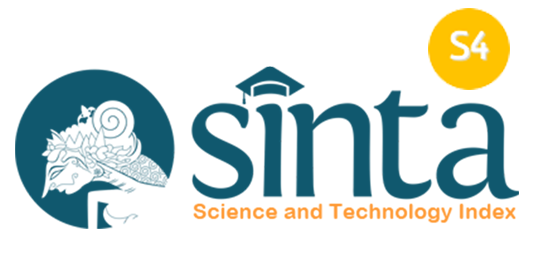Differentiated instruction in the mathematics classroom: Teachers’ teaching experience in a teacher professional development
Abstract
Differentiated instruction is an approach that can be used to facilitate students with various characteristics and help them to master mathematics in every topic learned. This study describes teachers’ performance in implementing differentiated instruction. In the second secondary school level, thirty mathematics teachers designed mathematics lessons using differentiated instruction in different topics, peer-reviewed, and peer-presented. Implementing the lesson in a real classroom was done while conducting classroom observation to see what works well during the learning process and improve it. Qualitative descriptive method was used to describe the process of research and analyze findings during the lesson through observation and forum group interview. From this process, teachers prepared instruction based on students’ abilities, took into account personal mathematics understanding, and helped students achieve mathematics learning goals. Teachers also learned strategies for helping students learned. Meanwhile, students enjoyed the learning process through their different ways of learning.
Keywords
Full Text:
PDFReferences
Algozzine, B., & Anderson, K. M. (2007). Tips for teaching: Differentiating instruction to include all students. Preventing School Failure: Alternative Education for Children and Youth, 51(3), 49–54. https://doi.org/10.3200/psfl.51.3.49-54
Avalos, B. (2011). Teacher professional development in teaching and teacher education over ten years. Teaching and Teacher Education, Vol. 27, pp. 10–20. Elsevier Ltd. https://doi.org/10.1016/j.tate.2010.08.007
Awofala, A. O., & Lawani, A. O. (2020). Increasing mathematics achievement of senior secondary school students through differentiated instruction. Journal of Educational Sciences, 4(1), 1-19.
Bondie, R. S., Dahnke, C., & Zusho, A. (2019). How does changing “one-size-fits-all” to differentiated instruction affect teaching?. Review of Research in Education, 43(1), 336-362.
Borja, L. A., Soto, S. T., & Sanchez, T. X. (2015). Differentiating instruction for EFL learners. International Journal of Humanities and Social Science, 5(81), 30–36.
Dixon, F. A., Yssel, N., McConnell, J. M., & Hardin, T. (2014). Differentiated instruction, professional development, and teacher efficacy. Journal for the Education of the Gifted, 37(2), 111–127. https://doi.org/10.1177/0162353214529042
Fountas, I. C., & Pinnell, G. S. (2018). Every child, every classroom, every day: From vision to action in literacy learning. The Reading Teacher, 72(1), 7-19.
Goddard, Y., Goddard, R., & Kim, M. (2015). School instructional climate and student achievement: An examination of group norms for differentiated instruction. American Journal of Education, 122(1), 111–131. https://doi.org/10.1086/683293
Hackenberg, A. J., Creager, M., & Eker, A. (2020). Teaching practices for differentiating mathematics instruction for middle school students. Mathematical Thinking and Learning, 1-30.
Hapsari, T., Darhim, & Dahlan, J. A. (2018). Understanding and responding the students in learning mathematics through the differentiated instruction. Journal of Physics: Conference Series, 1013(1), 012136. https://doi.org/10.1088/1742-6596/1013/1/012136
Ismajli, H., & Imami-Morina, I. (2018). Differentiated instruction: Understanding and applying interactive strategies to meet the needs of all the students. International Journal of Instruction, 11(3), 207–218. https://doi.org/10.12973/iji.2018.11315a
Kennedy, M. M. (2016). How does professional development improve teaching? Review of Educational Research, 86(4), 945–980. https://doi.org/10.3102/0034654315626800
Magableh, I. S. I., & Abdullah, A. (2020). On the effectiveness of differentiated instruction in the enhancement of Jordanian students' overall achievement. International Journal of Instruction, 13(2), 533-548.
Melesse, T. (2016). Differentiated instruction: perceptions, practices and challenges of primary school teachers. Science, Technology and Arts Research Journal, 4(3), 253. https://doi.org/10.4314/star.v4i3.37
Morgan, H. (2014). Maximizing student success with differentiated learning. The Clearing House: A Journal of Educational Strategies, Issues and Ideas, 87(1), 34–38. https://doi.org/10.1080/00098655.2013.832130
Njagi, M. W. (2014). Teachers ’ perspective towards differentiated instruction approach in teaching and learning of mathematics in Kenya. International Journal of Humanities and Social Science, 4(13), 236–241.
Parsons, S. A., Dodman, S. L., & Burrowbridge, S. C. (2013). Broadening the view of differentiated instruction: Differentiation shouldn’t end with planning but should continue as teachers adapt their instruction during lessons. Phi Delta Kappan, 95(1), 38–42. https://doi.org/10.1177/003172171309500107
Patterson, J. L., Connolly, M. C., & Ritter, S. A. (2009). Restructuring the inclusion classroom to facilitate differentiated instruction. Middle School Journal, 41(1), 46–52. https://doi.org/10.1080/00940771.2009.11461703
Pham, H. L. (2011). Differentiated instruction and the need to integrate teaching and practice. Journal of College Teaching & Learning (TLC), 9(1), 13–20. https://doi.org/10.19030/tlc.v9i1.6710
Postholm, M. B. (2012). Teachers’ professional development: A theoretical review. Educational Research, 54(4), 405–429. https://doi.org/10.1080/00131881.2012.734725
Pozas, M., Letzel, V., & Schneider, C. (2020). Teachers and differentiated instruction: Exploring differentiation practices to address student diversity. Journal of Research in Special Educational Needs, 20(3), 217-230.
Prast, E. J., Van de Weijer-Bergsma, E., Kroesbergen, E. H., & Van Luit, J. E. H. (2018). Differentiated instruction in primary mathematics: Effects of teacher professional development on student achievement. Learning and Instruction, 54, 22–34. https://doi.org/10.1016/j.learninstruc.2018.01.009
Ríordáin, M. N., Paolucci, C., & O’ Dwyer, L. M. (2017). An examination of the professional development needs of out-of-field mathematics teachers. Teaching and Teacher Education, 64, 162–174. https://doi.org/10.1016/j.tate.2017.02.001
Sharp, K., Jarvis, J. M., & McMillan, J. M. (2020). Leadership for differentiated instruction: Teachers’ engagement with on-site professional learning at an Australian secondary school. International Journal of Inclusive Education, 24(8), 901-920.
Schleicher, A. (2012). Preparing teachers and developing school leaders for the 21st century. In Andreas Schleicher (Ed.), OECD Education and Skills. OECD. https://doi.org/10.1787/9789264174559-en
Scigliano, D., & Hipsky, S. (2010). 3 ring circus of differentiated instruction. Kappa Delta Pi Record, 46(2), 82–86. https://doi.org/10.1080/00228958.2010.10516699
Sternberg, R. J., & Zhang, L. F. (2005). Styles of thinking as a basis of differentiated instruction. Theory into practice, 44(3), 245-253. https://doi.org/10.1207/s15430421tip4403_9
Tomlinson, C. A., & Moon, T. R. (2013). Differentiation and classroom assessment. In SAGE Handbook of Research on Classroom Assessment (pp. 414–430). United States: SAGE Publications, Inc. https://doi.org/10.4135/9781452218649.n23
Tomlinson, C. A., Moon, T., & Imbeau, M. B. (2015). Assessment and student success in a differentiated classroom. Alexandria, VA: ASCD Professional Learning Services.
Watts-Taffe, S., Laster, B. P., Broach, L., Marinak, B., Connor, C. M. D., & Walker-Dalhouse, D. (2012). Differentiated instruction: Making informed teacher decisions. Reading Teacher, 66(4), 303–314. https://doi.org/10.1002/TRTR.01126
DOI: https://doi.org/10.18860/ijtlm.v3i1.9699
Refbacks
- There are currently no refbacks.
Copyright (c) 2020 International Journal on Teaching and Learning Mathematics

This work is licensed under a Creative Commons Attribution-NonCommercial-ShareAlike 4.0 International License.
Indexed by :
.png)
.jpg)
.png)

.jpg)



